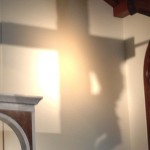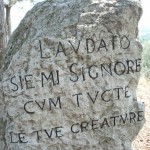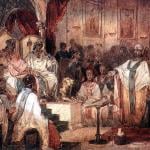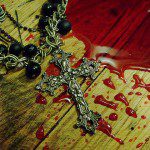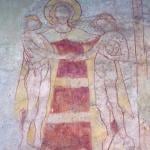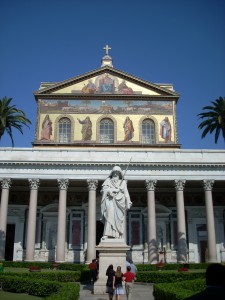 One of the first churches I visited in Rome was San Paolo fuori le Mura, the Basilica of St Paul Outside the Walls. I was there for the Papal Vespers celebrated on the Vigil of the Solemnity of Sts Peter and Paul in 2010. It was my first taste of the zoo that is a liturgy celebrated by the Holy Father. I was astonished to see that as soon as the entrance procession was signaled, the standing-room-only congregation who had been so reverently prayerful up to that moment suddenly leaped, as one, atop the temporary chairs that filled the knave and began snapping photos with the all the hyped-up aggression of paparazzi going after Alec Baldwin. So I saw only the tip of the Pope’s staff as he passed up the aisle, confirmed by the level of applause. (Roman congregations, I learned, cheer for all vaguely notable personages in the run-up to the Pope, but the decibel level reaches Beatles concert proportions for The Man.) I did get a slightly better view of Pope Benedict XIV later in the service, as he appeared, a tiny figure, on the distant Jumbotron set up before a side altar.
One of the first churches I visited in Rome was San Paolo fuori le Mura, the Basilica of St Paul Outside the Walls. I was there for the Papal Vespers celebrated on the Vigil of the Solemnity of Sts Peter and Paul in 2010. It was my first taste of the zoo that is a liturgy celebrated by the Holy Father. I was astonished to see that as soon as the entrance procession was signaled, the standing-room-only congregation who had been so reverently prayerful up to that moment suddenly leaped, as one, atop the temporary chairs that filled the knave and began snapping photos with the all the hyped-up aggression of paparazzi going after Alec Baldwin. So I saw only the tip of the Pope’s staff as he passed up the aisle, confirmed by the level of applause. (Roman congregations, I learned, cheer for all vaguely notable personages in the run-up to the Pope, but the decibel level reaches Beatles concert proportions for The Man.) I did get a slightly better view of Pope Benedict XIV later in the service, as he appeared, a tiny figure, on the distant Jumbotron set up before a side altar.
I have to confess, though, that it was the basilica itself that was the star for me that day and later in the week when our tour group returned for a more peaceful closeup. I had given illustrated lectures on Church art that featured the apse mosaics, with their Byzantine palm trees—just like the palm trees outside the basilica! I don’t know why Rome’s palm trees came as such a surprise, but I felt like I was back home in LA—flanking Christ the Just Judge, a teeny-tiny Pope Honorius III, the 13th-century pontiff who commissioned the murals, curled up by Jesus’ right foot, about to kiss a regal toe. To see the mosaics in person, the shimmer of glass and gold that no photograph can capture, was immensely moving. (I gave thanks then, and give thanks always, to the Vanderburgh Family for making it possible.)
 So I was delighted to see that Kathy Schiffer has called attention to St Paul Outside the Walls in her Seasons of Grace blog, spotlighting the major reconstruction of the Basilica that occurred 189 years ago next week. Though this was the most ambitious reworking of San Paolo—necessitated by a devastating fire—it was by no means the first in the church’s long history, and I can’t help but see in that a sign of hope in these days when speculation about the Church’s survival abounds both within and without her walls. Some points for reflection:
So I was delighted to see that Kathy Schiffer has called attention to St Paul Outside the Walls in her Seasons of Grace blog, spotlighting the major reconstruction of the Basilica that occurred 189 years ago next week. Though this was the most ambitious reworking of San Paolo—necessitated by a devastating fire—it was by no means the first in the church’s long history, and I can’t help but see in that a sign of hope in these days when speculation about the Church’s survival abounds both within and without her walls. Some points for reflection:
Founded on the Apostle, Literally
The original basilica (from the Greek for royal building, because this model of Christian church is based on the audience halls of Byzantine rulers) was built by our old pal Constantine, he of memory both blessed and cursed, on the site where, by popular tradition, the remains of St Paul were interred after his beheading. Paul was a citizen of Rome, even if a heretic to Rome’s gods and to the Judaism of his birth, so he was entitled to a citizen’s burial—outside the walls of the city, as was the rule for all burials in ancient Rome. Recent excavations under the basilica have yielded burial materials consistent with the era of Paul’s martyrdom, and there are plans to transfer what might be the saint’s remains to join those of St Peter in the Vatican.
Since the earliest days, we as Church have also built on the foundation laid by the life of the Apostle to the Gentiles, and we have had reason to be both grateful to Constantine and troubled by the imperial legacy he left us.
Ad Orientem
As Kathy Schiffer points out, San Paolo is one of the places in Rome where the Church’s Eastern blood continues to be most recognizable. The mosaic tradition began as early as the 4th century, when the Emperor Theodosius erected a larger and more lavish church on the site of Constantine’s original. For 700 years, San Paolo was the home church of the Latin Patriarch of Alexandria, so it has always helped us to keep one eye turned to the East.
At a time when we in the US tend to go on a bit more than we should about how we’re being persecuted, it’s good to have a reminder of how we are linked to a long tradition of survivors of real persecution in the East—and to continue to “look East” in prayer and solidarity with them.
In the Midst of the World
 For a good part of its history, St Paul Outside the Walls was isolated by its location, but in the 20th century industrial development and low-income housing sprang up around the basilica. There have been attempts to buy back some of the surrounding land to create buffer zones of greenspace, but as my photo shows, San Paolo is now firmly in the world, if not of it.
For a good part of its history, St Paul Outside the Walls was isolated by its location, but in the 20th century industrial development and low-income housing sprang up around the basilica. There have been attempts to buy back some of the surrounding land to create buffer zones of greenspace, but as my photo shows, San Paolo is now firmly in the world, if not of it.
And that’s as it should be. As Church, we need fewer buffer zones and walls, more open doors and open arms.
Surviving, Renewing
Over the centuries the basilica survived Saracen invasions, earthquakes, the rise and fall of a double monastery on its grounds, being renewed and rebuilt in part while preserving its original character longer than almost any other church in Rome. Then came the catastrophic fire of 1823, and the world’s response to raise San Paolo from the ashes.
I think St Paul Outside the Walls is a model of the Church in miniature that way. The building made of living stones, built on Christ the cornerstone, has survived many an assault, has renewed and rebuilt itself, has let the world in, even at risk of martyrdom. I have faith that it will be ever so, until we are called home to meet the Just Judge at last.



